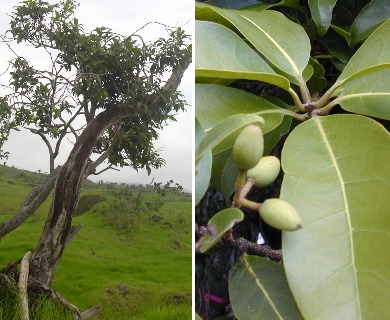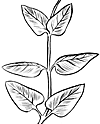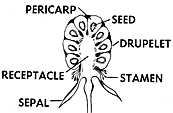Olopua
Nestegis sandwicensis
Ash/Privet family (Oleaceae)
Native species ()
This medium-sized tree is common in dry forests through the islands. It has paired elliptical or lance-shaped leaves, small yellowish green flowers clustered at leaf bases, and small green turning to bluish black Usually a small tree of 20 ft (6 ) in height with short stout trunk to 8 inches (0.2 ) in diameter and rounded sometimes medium-sized to 66 ft (20 ) and 3 ft (0.9 ). Bark gray, rough, furrowed into ridges and plates; inner bark brown, dry, bitter. Twigs light gray or light brown with raised dots and paired raised half-round leaf-scars. Buds are scaly, pointed, gray, 1⁄8 inch (3 ) long, and finely hairy.

©2004 Forest And Kim Starr
Flower clusters () 1–2 inches (2.5–5 ) long at leaf bases, unbranched. Flowers several in pairs, short-stalked, less than 1⁄4 inch (6 ) long and broad, composed of four- minute green yellowish or whitish green more than 1⁄8 inch (3 ) long, deeply four- four attached on base of and with and with conical greenish two-celled short and two-
() egg-shaped, 1⁄2–7⁄8 inch (13–22 ) long, blunt at green turning to bluish black, slightly fleshy but becoming dry, the large stone single-seeded.
Sapwood is yellow and heartwood yellowish brown or dark brown with blackish streaks. Wood is fine-textured, very heavy, and very hard, with indistinct growth rings. It is very durable and takes a fine polish. Formerly used by the Hawaiians for tool handles such as adzes and as a rasp for fishhook manufacture. It was a preferred fuelwood because it gave a hot fire even when green. Not presently used.
This species is a favorite host for Hawaiian land snails.
Widespread through the islands, especially in dry forests, at 1000–4200 ft (305–1280 ) altitude.
Special areas
Kokee, Wahiawa, Volcanoes, Kipuka Puaulu
Champion
Height 54 ft (16.5 ), c.b.h. 10.2 ft (3.1 ), spread 31 ft (9.4 ). Hoomau Ranch, Honomolino, Hawaii (1968).
Range
Through the Hawaiian Islands, not known elsewhere.
Other common names
Hawaiian-olive, ulupua
Botanical
Osmanthus sandwicensis (Gray) Knobl.
This is the only native species of the olive family, Oleaceae. Several others are introduced.
Eleven tree species in this handbook commemorate the early English name for Hawaii, the Sandwich Islands. Six, including the olopua, were named by Asa Gray, U.S. botanist of Harvard University. Captain James Cook of the British Navy named the islands in 1778 in honor of John Montagu, Earl of Sandwich, who had sponsored Cook’s expedition.









